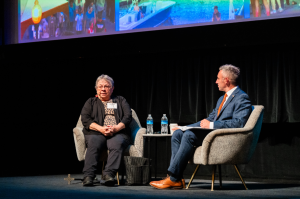Ask Mary: How Can Main Streets Be Effective Community Leadership Organizations?
In October 2024, the Maryland Department of Housing and Community Development and the Maryland Economic Development Association hosted the first ever Main Street Maryland Conference, recognizing Maryland’s beloved Main Streets and the warm, authentically local experiences that is cultivated in those spaces.
Main Street Maryland managers, board members, community teams, volunteers, advocates, and economic and community developers from across the state converged in Frederick for a day of engaging presentations, experiences, and perspectives that highlight the treasures of Maryland’s local communities and foster thought-provoking conversations to shape a treasured future ahead.
One of the conference’s speakers was Mary Means, an award-winning community planner and innovator.

While working at the National Trust for Historic Preservation in the 1970s as shopping centers were emptying downtowns, Means knew small towns would need a plan to inject life back into its town centers. The framework from that original plan evolved in the last four decades into Main Street America, a collaborative movement that advances shared prosperity, creates resilient economies and improves quality of life through place-based economic development and community preservation in downtowns and neighborhood commercial districts across the country.
Means, dubbed the “Mother of Main Streets,” took some time to answer questions submitted by Main Street Maryland managers from across the state on how to solve the challenges they face in their communities. Today, we’re sharing her first response.
Taylor Schwartz, Executive Director, Federal Hill Main Street: How do you see Main Streets being the most effective community leadership organizations in rural settings versus urban settings?
Mary Means: Whether in a rural or urban setting, an effective Main Street organization is a tremendous asset for community leadership.
As to its being the most effective, this depends on context, starting with other leadership organizations that are active in the community, whether urban or rural. In urban settings there are often several civic organizations at the city-wide level. Their missions can be economic development, arts, education, health, housing or other fields. Some larger communities may also have “Leadership [insert name of city]” programs that identify and nurture promising candidates for community leadership and expose them to the range of opportunities in need of volunteer talent.
At the urban neighborhood level, there are often community development corporations, which might be focused in several categories, such as housing and jobs. There may be other allied volunteer-led organizations, including BIPOC business groups. In small communities, there are fewer such organizations, but one of them is usually a chamber of commerce.
In both urban and rural settings, there is likely some overlap with the work of a Main Street organization. The bigger the community, the more likelihood of multiple cooks in the kitchen, or at least kitchen-adjacent. Ideally, there is a collaborative environment. Main Street is known for its high level of volunteer engagement, so keeping a steady stream of volunteers in the pipeline is very important for succession and to prevent burnout in a few uber-volunteers.
Three issues seem important to include in answering your question.
Collaboration among the various entities active in the Main Street district benefits all involved, for nothing motivates volunteers like getting something done together, to be making a difference. Time spent in turf defense or going it alone can easily mar Main Street’s effectiveness.
Recruiting leaders within – and beyond – the Main Street district. Healthy organizations have steady turnover on the board, new talent arriving to replace those who move on. Long before an opening occurs, it is wise to be identifying promising candidates and personally reaching out to them. Why look beyond the district? Because a Main Street organization can benefit from expertise or relationships that are not present in the district. And since ‘main street’ is the heart of small communities, it should be the responsibility of everyone in the community to be involved in its health, whether as an event volunteer or board member.
Strength from multiple voices. An organization active in the heart of the community needs to reflect the composition of the community – men, women, youth, ethnic identity, and more. Budding leaders come from all walks of life. Service to a Main Street organization may well be the first rung of deeper involvement in the community. One thing is apparent. For the most part, those communities with a Main Street organization were able to pivot more rapidly when pandemic shutdowns drastically impacted small businesses. One can only surmise that the Main Street organization’s established trusting relationships across a wide range of community institutions, including local government, were invaluable to the district’s resilience.
